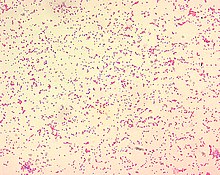User:Mr. Ibrahem/Brucellosis
| Brucellosis | |
|---|---|
| Other names | Remitting fever, undulant fever, Mediterranean fever, Maltese fever, Malta fever, Gibraltar fever, Crimean fever, goat fever, Bang disease, rock fever[1][2] |
 | |
| Specialty | Infectious disease |
| Symptoms | Fever, headache, muscle pains, joint pains[3] |
| Complications | Testicular inflammation, endocarditis, spleen enlargement[4] |
| Usual onset | 2 to 4 weeks after exposure[4] |
| Types | B. abortus, B. canis, B. melitensis, B. suis[1] |
| Causes | Brucella[1] |
| Risk factors | Unpasteurized dairy products, undercooked meat[5] |
| Diagnostic method | Blood cultures, agglutination testing[1] |
| Differential diagnosis | Infectious mononucleosis, malaria, leptospirosis, meningitis[1] |
| Treatment | Antibiotics[4] |
| Prognosis | Recover can take 6 months[1] |
| Frequency | >500,000 a year[6] |
| Deaths | 2% risk of death[1] |
Brucellosis is an infection caused by bacteria of the Brucella type.[1] Symptoms may include fever, headache, muscle pains, and joint pains.[3] Symptoms typically occur 2 to 4 weeks after exposure and may come on gradually or suddenly.[4] Without treatment infection may lasts for years.[1] Complications may include testicular inflammation, endocarditis, miscarriage, septic arthritis, or enlargement of the spleen.[4][1]
Infections in humans are caused by four specific types of Brucella: B. abortus, B. canis, B. melitensis, and B. suis.[1] As few as 10 to 100 organisms can result in disease.[1] It most commonly spreads as a result of eating unpasteurized dairy products from infected animals.[5] It may also occur from eating undercooked meat or working with infected animals.[5] Rarely spread may occur between people.[5] Diagnosis is usually by blood cultures or agglutination testing.[1]
Treatment of those over the age of 8 is a combination of doxycycline and rifampin for 6 weeks.[4] Younger people may be treated with trimethoprime/sulfamethoxazole.[4] Different antibiotics may be used for complications.[4] Exercise may speed recovery.[1] Death occurs in 2% of cases.[1]
Over 500,000 cases are reported a year as of 2009.[6] In 2010, 115 cases were diagnosed in the United States.[1] Areas more commonly affected include those bordering the Mediterranean, Central and South America, Asia, Africa, and the Middle East.[7] Brucellosis was first described in 1751 by George Cleghorn.[1] The disease is named after Sir David Bruce who was involved with identifying the bacteria involved in 1886.[1]
References[edit]
- ^ a b c d e f g h i j k l m n o p q r Hayoun, MA; Muco, E; Shorman, M (January 2020). "Brucellosis". PMID 28722861.
{{cite journal}}: Cite journal requires|journal=(help) - ^ Griffiths, Jeffrey; Maguire, James H.; Heggenhougen, Kristian; Quah, Stella R. (2010). Public Health and Infectious Diseases. Elsevier. p. 112. ISBN 978-0-12-381507-1.
- ^ a b "Signs and Symptoms | Brucellosis | CDC". www.cdc.gov. 9 October 2018. Retrieved 17 December 2020.
- ^ a b c d e f g h Brucellosis Reference Guide: Exposures, Testing, and Prevention (PDF). CDC. February 2017.
- ^ a b c d "Transmission | Brucellosis | CDC". www.cdc.gov. 11 March 2019. Retrieved 17 December 2020.
- ^ a b Inc, Gideon Informatics; Berger, Dr Stephen (2020). Brucellosis: Global Status. GIDEON Informatics Inc. p. 14. ISBN 978-1-4988-2801-7.
{{cite book}}:|last1=has generic name (help) - ^ "Areas at Risk | Risk of Exposure| Brucellosis | CDC". www.cdc.gov. 17 October 2018. Retrieved 17 December 2020.
